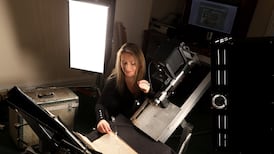MEDICAL MATTERS:The body delivers a gentle reminder of ageing, writes MUIRIS HOUSTON
I’M JUST BACK from a visit to my optometrist. I’ve been short-sighted (myopic) since my late teens and have happily worn glasses since. Never one for contact lenses, neither have I been tempted by the various vision-correcting surgical options developed in recent years.
However, while on holiday this year I found I could no longer read newsprint while wearing my glasses. And
text messaging was also a growing problem, albeit one amenable to temporary remedy by virtue of the text enlarging function on my mobile phone.
In any case, I was pretty sure what the problem was and so I made an appointment to see Ciara. Sure enough, she confirmed I now had presbyopia.
The condition reduces the ability of the eye to focus on near objects, due to a reduction in the flexibility of the lens. Found in those aged 40 and over, it is one of the body’s more gentle reminders of ageing.
For me, it means I now require bifocals; for someone not already short-sighted it signals a need for reading glasses.
If you think of the eye as a hollow, fluid-filled, three-layered ball, then the outer layer is the tough-coated sclera, the innermost is the retina which is thin and gathers light to it and the middle layer is called the uvea.
Near the front of the eye, the sclera is covered by a thin mucous membrane (conjunctiva), which runs to the edge of the cornea and also covers the moist back surface of the eyelids.
This middle layer, the uvea, is made up of the iris and the ciliary body towards the front of the eyeball and the choroid which is situated further back.
As we age there are changes to the sclera (the white of the eyes) such as yellowing or browning due to many years of exposure to ultraviolet light and dust; random splotches of pigment especially in people with a dark complexion; and a bluish hue due to increased transparency of the sclera.
Tear production may also decrease with age, so that fewer tears are available to keep the surface of the eye moist. This is one of the reasons why some older people are plagued with dry eyes.
A deposit of calcium and cholesterol salts appears as a gray-white ring at the edge of the cornea. Called arcus senilis, it does not affect vision.
The muscles that squeeze the eyelids shut decrease in strength with age. This decrease in strength, combined with an age-related looseness of the eyelids, sometimes results in ectropion, a condition in which the lower eyelid falls away from the eyeball.
The muscles that work to regulate the size of the pupils also weaken with age. The pupils become smaller, react more sluggishly to light, and dilate more slowly in the dark.
Therefore, people older than 60 may find that objects are not as bright and that they are dazzled initially when facing oncoming cars during night driving.
Other changes in eye function also occur. The sharpness of vision is reduced even with use of the most up to date glasses, especially in people who have a cataract, macular degeneration, or advanced glaucoma.
The amount of light that reaches the back of the retina is reduced, increasing the need for brighter illumination and for greater contrast between objects and the background. Older people may also see increased numbers of floating black spots (floaters).
Ciara took retinal photographs; looking at the extraordinarily clear images afterwards it was good not to see any signs of high blood pressure or diabetes, which appear as blotchy exudates on the retina. Macular degeneration and retinal detachment are other retinal diseases associated with ageing.
But at least the rest of the examination is normal. I don’t have glaucoma, which is found more frequently in those of us who are short-sighted. And with varifocals now an option for someone who is both myopic and presbyopic, I’m spared the giveaway two-part lens of the bifocally bespectacled . . . at least for now.









